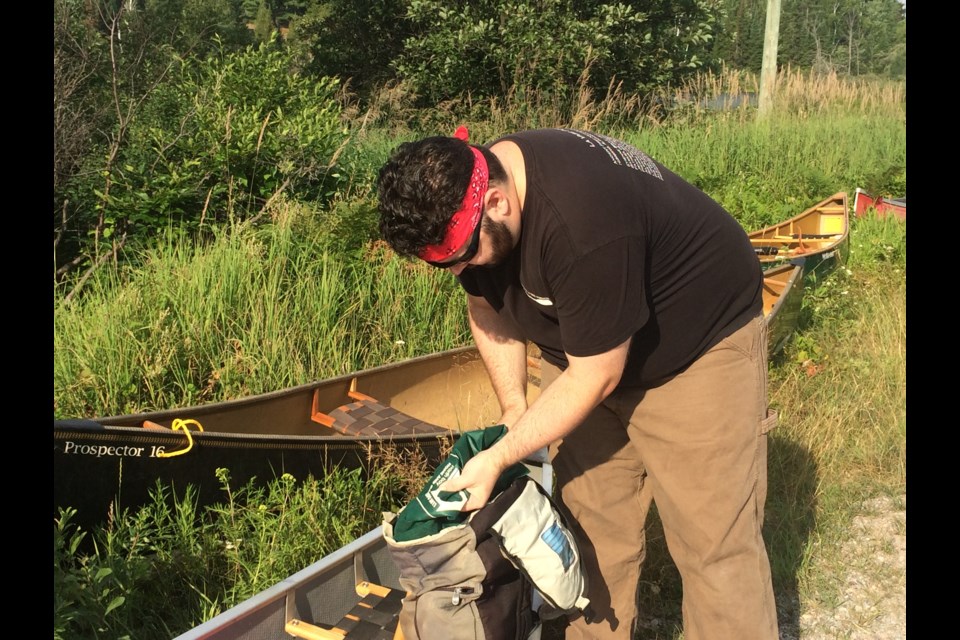Accepting an invitation from their daughter, Linda Viejou and her husband drove from Parry Sound to canoe in the 13th annual Friends of La Vase Portages Canoe Day.
“Our daughter who lives in North Bay loves canoeing and knows we enjoy it, so she invited us here for the day. I’ve canoed before, but this is my first time here. I’m looking forward to being outdoors, seeing sights we haven’t seen and heard a little bit the history which I think will be an interesting part of it. I’m looking forward to a learning expedition and a fun day,” said Viejou.
Daughter Jill Viejou has experience paddling from North Bay to Mattawa, and around Parry Sound quite a bit.
“I thought connecting the route from Trout Lake to Nipissing would be a neat, new addition to my canoe paths,” said Viejou.
“I’m really looking forward to seeing how Trout Lake connects to Nipissing, and hearing about the history and hoping to find a smaller section that I’m able to do with my children later on, that’s not the full 14 kilometres. Just a couple kilometres maybe around the lower part that I can take them out for a few hours.”
Canoeing enthusiast Chris Mayne is known for his breathtaking pictures of his many trips, including this one.
“It’s a wonderful historic canoe route. It’s really impressive to see what’s still there,” said Mayne.
Darren Patey, Chair of the Friends of La Vase Portages, say canoe day is a great way to introduce people to the local history.
“Every year we invite the community and visitors from out of town to come to join us on a historical canoe voyage from Trout Lake to Nipissing, crossing a height of land in between the two, so really it’s the division between the two lakes, said Patey.”
“It’s the route that probably about 80% of the fur trade had to pass. It’s how the voyageurs came through. It’s where the First Nations showed them the way. The route is really quite fascinating.”
A plaque erected by the Ontario Archeological and Historic Sites Board at the La Vase Portage Conservation Area, just a few minutes drive from North Bay on Hwy 17, towards Ottawa, outlines the significance of the route.
“The three portages connecting Trout Lake and the lower La Vase or “mud” River were linked by small streams and ponds. They formed part of the great canoe route via the Ottawa and Mattawa Rivers, Lake Nipissing and the French River, leading to the upper Great Lakes and the west, which was followed by the early explorers, missionaries, and fur traders. Among the many famous men who passed this way was Samuel de Champlain, Father Jean de Brebeuf and Sr. Alexander MacKenzie.”
Guides took the canoeists along a portion of the route which stretches for 14 kilometres.
“Their backgrounds are anything from canoe enthusiasts who just love going on canoe trips to, people who are well versed in reading maps and historian types. The main thing we have in common is we love this route. It’s fantastic. It’s so rich with information. Anyone can watch a video on YouTube, but to feel the grass, to have the sun on your face and to look at the same rocks that they were looking at thousands of years ago feels amazing,” said Patey.
Since joining the Friends of La Vase, Roy Summers has paddled his way along this route at least 25 times.
“I’ve spent a lot of time in this area. It’s kind of been my playground, including the La Vase Portages. I’ve taken people through on expeditions. It’s a very memorable route because it can be tough.”
The trail has been kept as natural as possible. The only thing out of the ordinary may be a few neon ribbons, or a couple canoe diamonds and a few signs to respect private landowners.
“Depending on how much water we’ve got, which today I’m not sure we’re going to have too much water with us, it’s a lot more paddling with more water. We do have a few portages but the hard part is at the start, so if you can pass that it’s smooth sailing the rest of the way,” said Patey.



